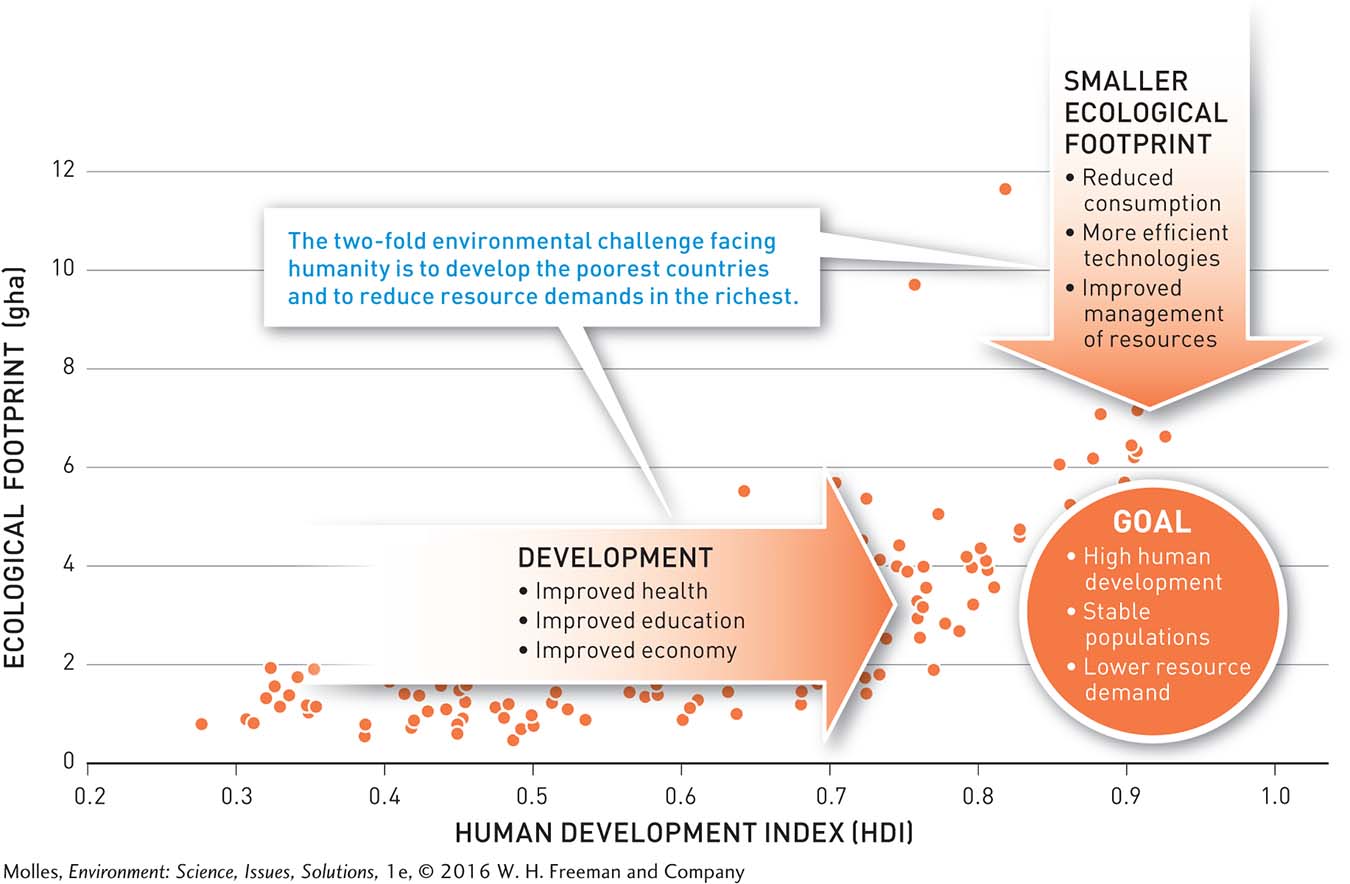5.10 The challenge: Achieve high development and sustainable resource use
We often forget that at some point in their histories, the populations of all of today’s developed countries went through a transformation from very low development to high development. Consider Iceland, which has an infant mortality rate of less than 3 deaths per 1,000 live births, one of the most favorable in the world. However, conditions were quite different as late as the 19th century. From 1840 to 1890, Iceland’s infant mortality rate was 250 to 300 deaths per 1,000 live births, and in one disastrous year, 1846, Iceland’s infant mortality rate rose to 600 deaths per 1,000 live births. This is more than 3 times the infant mortality rate in any country on Earth today!
According to an analysis by Icelandic economist Thorvaldur Gylfason, Iceland’s per capita economic output in 1901 was about $2,600, approximately that of Bangladesh in 2011. Since then, Iceland has grown its economic sector by about 2.6% annually, mainly through careful management of productive fishing grounds and renewable energy sources, rising to a per capita GDP of about $42,000 in 2013, according to the World Bank. However, the most important contributor to this growth may come as a surprise: education.
Literacy in Iceland stands at 99.9% of the population. Education is compulsory through age 16 and attendance through that age is estimated at 99%. According to Statistics Iceland, close to 27,000 Icelanders (nearly 10% of the entire population) received university degrees between 1999 and 2008. Of this total, nearly twice as many degrees went to women as men.
Iceland has a democratically elected parliamentary system of government in which all citizens 18 years or older are entitled to vote for president and members of parliament. Empowerment of women extends to the highest levels of involvement in Iceland. Women made up 30% of the Icelandic parliament in 2004, compared with 20% of the U.S. Congress. As a final testament to women’s empowerment, Jóhanna Sigurdardóttir was selected as Iceland’s first woman prime minister, the head of the government, in 2010.
Improvements in health, along with high levels of education and literacy, a rich natural resource base, and universal suffrage and empowerment of women, contribute to Iceland’s high level of development. They are also key factors in its movement toward a stabilized population. While we might consider Iceland exceptional in many ways, other countries have also made rapid developmental progress in the recent past. Costa Rica, a tropical Latin American country, is making rapid progress toward population stability. Like Iceland, Costa Rica’s success owes much to heavy investment in education at all levels, universal suffrage, and empowerment of women. In 2014 the percentage of women in Costa Rica’s Legislative Assembly was 33%, compared with 18.5% in the 113th U.S. Congress. In addition, like Iceland, Costa Rica elected its first woman head of government in 2010: President Laura Chinchilla Miranda.
The Challenge
The challenge for humanity is to invest in human development while reducing demand on Earth’s resources (Figure 5.31). In this chapter, we have focused primarily on the need to reduce human population growth, which may be achieved by providing access to family-

The slowing of world population growth that we’ve already reviewed (Figures 5.3b and 5.3c, page 131) is a good sign of progress. Progress toward curbing explosive population growth is, of course, being played out within individual populations. Bangladesh, the country discussed at the beginning of this chapter, has made dramatic strides toward that goal, with family-

If you had the authority and the means to do so, how would you meet the twin global challenges identified in this section?
Think About It
On average, what is the relationship between a nation’s Human Development Index and its per capita ecological footprint?
What is the environmental and sociological significance of differences in ecological footprints among countries with similar Human Development Index scores?
How do the countries of Iceland and Costa Rica differ? How are they similar?
5.8–5.10 Solutions: Summary
Most countries have national population policies that promote decreasing, increasing, or maintaining fertility levels, depending on the population trend in individual countries. Other nations, particularly in the Americas, have no official policies regarding fertility levels. Educating and empowering women, which includes encouraging contraceptive use, can reduce fertility rates in rapidly growing populations. The national population policies of China and India have succeeded in reducing their rates of population growth. Prenatal sex screenings, coupled with sex-
Historical improvements in living conditions in today’s developed countries led to demographic transition, a shift from high to low death rates and birthrates. Most developing countries are now in the middle to late stages of demographic transition. Worldwide investment in development may accelerate the passage of developing countries through demographic transition and slow the rate of global population growth. By reducing economic disparities across borders, investment in development in less developed countries may reduce incentives to immigrate.
Development generally comes at an environmental cost; on average, countries with higher developmental scores have larger ecological footprints. However, some countries have achieved high levels of development at a relatively lower cost to the environment. The two-

How might development among the least developed countries be achieved without making them dependent on aid from more developed nations?